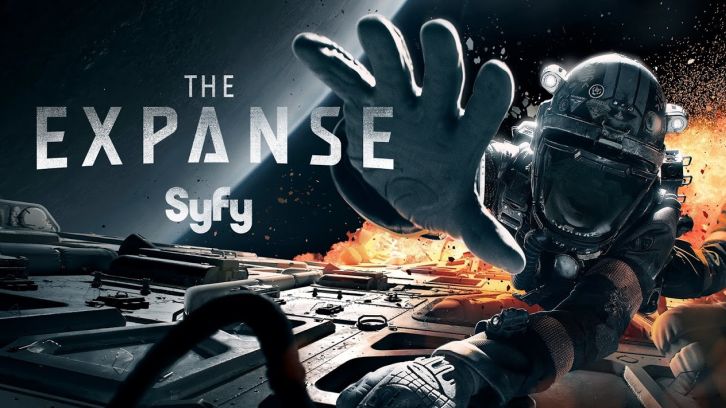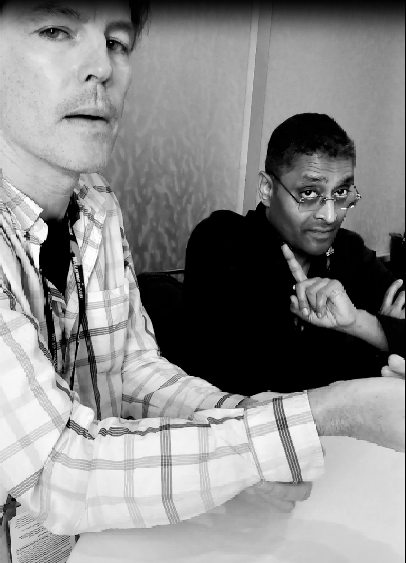It's Fun To Stay at the Blue Falcon Hotel: The SyFy Interviews, The Expanse
Based on the sci-fi mystery novels penned by James S.A. Corey (a nom de plume serving the endeavours of the writing team Daniel Abraham and Ty Franc, Leviathan Wakes) The Expanse titles have spread like flowering spores into a SyFy original series. Some two-hundred years in the future, a now-fully-habitable solar system serves as the ripe-for-rivalry mise-en-scène. Space provides the optimum landscape, especially space under colonial administration, to host not one, but all three classical conflicts of storytelling: man vs. man, man vs. nature, and man vs. himself.
It is in this expanse where a new breed of mankind operates in roughly the same rigid, egocentric and tenuous fashion that ancient mankind did when Earth was, essentially, his only domain; yet, now there is more territory to cover and more peoples to monitor, and control. If resources, greed, logistics, prejudices, power trips and egos proved existential beasties on one planet, whilst the endgame may remain the same when dealing with an entire solar system, the wider struggle proves a significant hurdle.

In The Expanse, dominant Earthlings, militant Martians and second-class Belters (those living and working in space, in the asteroid belt) clash like Real Housewives thrown together at a theme party. As the humans delicately co-exist, the United Nations - yes, still in "action" - persuades against a roiling warfare burgeoning between Earth and Mars, under the auspices of violet-cloaked U.N. exec Chrisjen Avasarala (played regally by Shohreh Aghdashloo whom, if you know your Portlandia, will recognize her from S2e3 as the visiting author at Women and Women First.).
In these potentially warring skies, Captain James Holden (Steven Strait) and his skeleton crew of the ice trawler Canterbury face a more immediate concern: who blew up their ship? Fortunately, Holden and his crew were saved from annihilation, as they all happened to be on a (set-up?) distress call, on-board a Canterbury short-range shuttle. So, who killed the Cant? The offending machine was a stealth vessel. Who has the funds for, and access to, a stealth vessel. The war-happy Martians, of course ... or was it?

Whilst scouring the colonies for the real Canterbury destroyer, Captain Holden and his stragglers, Naomi Nagata (Dominique Tipper), Alex Kamal (Cas Anvar) and Amos Burton (Wes Chatham), are hired by Outer Planets Alliance (OPA): a quasi-terrorist organization fighting for the rights of the second-class Belters. Their mission? To find a missing compatriot, one Lionel Polanski. On their travels, in their new ship, Rocinante, they locate the very vessel that took out the Cant: the Anubis. A seemingly abandoned ghostship, there's plenty of life in the old girl yet. The Anubis is festering with "spiraling layers of an amorphous, glassy, blue-green mass, clutching the reactor like a strangler fig". A self-aware protomolecule, the Phoebe Bug, as it were.

Elsewhere, a young, wealthy scion named Julie Mao goes missing. On the case is hard-living, self-damaged Det. Joe Miiller (Thomas Jane). When it is learned she is, in fact, OPA-sympathizer Lionel Polanski, Miller follows her alias until he finds she is registered at the Blue Falcon Hotel, as Polanski. Oddly, she is covered in the same Phoebe Bug that took control of the Anubis. The spaceship that killed the Cant and the disappearance and bizarre death of Julie Mao/Lionel Polanski can't be related ... or can they?
As with any quality, conspiracy-heavy sci-fi series, the simple, seemingly unrelated elements of a workaday spaceship, a self-aware, extra-terrestrial protomolecule and a dead, Phoebed, rich girl must be connected, and all via top-level, high-stakes, interplanetary, 23rdC. battle for air and water ... or must they?
San Diego Comic-Con 2016 and the good folks at SyFy afforded Yours Truly a seat at The Expanse roundtable, for a bit of chat and interview with the series' cast and writers. When I asked exec producers/writers Mark Fergus and Naren Shankar for a hint of what's to come in S2, specifically the self-aware Phoebe Bug, I was given a deftly crafted non-answer and, as the picture shows, a couple of Paddington Bear-style "very hard stares".
Jennifer Devore: Obviously, you can't give any direct hints as to the next season, but ... in the beginning of next season, will the origins of the discovery, of the spores or matrix, will that be divulged, or, and I apologize f it sounds like I'm asking a derivative question, but will it be similar to something like "Helix" or "The X-Files", where, like, the black oil becomes its own character throughout season after season ... or, will it be solved right away?

Naren Shankar: Yeah, yeah, yeah. You're going to get some answers for sure. No question about that. But, like the books, what it does is, it keeps changing. So, you can't ask anybody questions about that! You have to figure it out.
Mark Fergus: One of the joys of the books is it takes you, you know, three books before you really understand what this thing is. But it is something v specific, the mystery of it is ... there's no reason to put yourself in the shoes of your characters, trying to figure out what it is. Ultimately it does become its own character in the sense that it's become the elephant in the room for humanity. It's the new thing we have to grapple with. But, this show is about how does a new, game-changing technology change humanity? It is always about people. it's not about this thing. The thing never becomes more important than how do people ... deal with ... a new reality, given that it now exists.
Jennifer Devore: Whiich is very apropos to current events.
Mark Fergus: Absolutely. This show is about people. The beauty of the books is, it never starts to say, "Oh, this thing is so cool, let's leave our people behind and follow this cool, interesting, game-changing thing." The story is about how our guys are going to survive and react to that. That will always be our focus.
The Expanse S1 streams on Amazon beginning December 2016; S2 starts on SyFy January 2017. Need a little S2 tease? Voila!
{youtube width="580" height="380"}3gj8tRaFIfs{/youtube}
The Expanse
Creators
Mark Fergus
Hawk Ostby
Executive producers
Naren Shankar
Mark Fergus
Andrew Kosove
Sharon Hall
Sean Daniel
Jason F. Brown
Hawk Ostby
Broderick Johnson
Producer
Lynn Baynor
Prod. Companies
Penguin in a Parka
SeanDanielCo
Alcon Entertainment
Distributor
NBC Universal TV Dist.
Original Network
Read Jennifer Susannah Devore's) previous SDCC/SyFy roundtables with the cast and writers of Helix: So Many Monkeys and It Ain't Easy Being Human: SyFy Interviews
JennyPop’s other fave places to lurk online?
amazon.com/author/jenniferdevore
#SDCC2016 #The Expanse #SyFy
Con Crud and The Comic-Con Blues: JennyPop's SDCC 2014 Wrap and Dr. Lucy's Slideshow
"Normality" reigns once again: only the corset welts remain and, thankfully, those are fading fast. (Beach parties are never far off around here; always lurking in the shadows, like Homey the Clown with a sock full of nickels in a dark alley. Ka-pow! Guess what? You're going to a luau, girl! Damn it. Where's my parasol?)
Need a Moment to Think? Learn The Lorem Ipsum Lip
Lorem ipsum dolor sit amet, consectetur adipisicing elit … Memorize it, kids. It could come in handy. If Lorem ipsum can work as a centuries-old, standard placeholder for text, why not for speech? Consider the awesome applications: political conversations over the holidays; awkward, totally unexpected, sexual advances by a friend; foot-tapping queries about your Internet-browsing history; traffic stops by your local boys in blue. (On second thought, don’t give coppers the Lorem Lip. They don’t seem to have much of a sense of humor these days.) In fact, the mysterious, quietly-omnipresent Lorem ipsum we all know and love has been used as a text placeholder, almost as long as there has been text … almost.
Bored with telling the same stories at every Fourth of July, Thanksgiving and Super Bowl party, ancient Chinese Buddhists living circa 650 C.E. decided it a far better idea to share their holy texts with loved ones via print: enter stage-left, the first movable type, Chinese woodblock. Using rag paper methods learned from the far reaches of the Islamic Empire (Mesopotamia 3,000 B.C.E. being the birthplace of cuneiform handwriting and, eventually, putting all that to paper), these scholarly Buddhists, notably Wong Jei in 886 C.E. who printed a scroll for his parents, believing it to bring them good luck, set about printing many a scroll filled with kindly, Buddhist tenets. These kind ideas were met with mass silencing and murder of the printers by their own government, not to mention the burning of those very nice scrolls.
Fast forward to 1450-55 C.E.. Johann Gutenberg replaced the wood and clay, blocked type (whole pages set vs. individual characters) with metal type and printed the first substantial, commercial book with individual, movable type: The Gutenberg Bible. Some sixty years after that, Martin Luther would use movable type to tell the Catholic Church a thing or two about a thing or two.
On Hallowe’en Night 1517, Luther tacked his Ninety-Five Theses on a church door in Wittenberg, Germany, arguing against the Church’s “sale of indulgences”: basically buying one’s way out of purgatory. Before the Church could say “Hail, Mary!”, scores of Luther-fans, using Gutenberg’s printing press method, helped spread The Ninety-Five Theses all over Europe, much to Catholicism’s dismay.
By the by, there are forty-six surviving copies of original Gutenberg Bibles, most of them resting peacefully in Germany. There are, however, eleven in the United States. If you know how to have fun the right way, including throwing around words like incunabula, and are fortunate enough to live near The Huntington Library, Yale, Harvard, the Library of Congress, Indiana University or any of the other American venues, I suggest you treat yourself to one of mankind’s wonders of ingenuity, before the growing masses of half-wits and jelly beans make the printed book completely obsolete.

Anyhoo, to the point of all this: Lorem ipsum is merely dummy text used until permanent text is put in place. Designers and printers have long realized that potential clients will be distracted by actual content when perusing a spec piece of print: pamphlets, books, theater bills, advertisements, etc. Lorem ipsum looks just enough like a natural distribution of letters and phrases to fool the brain, without taking focus off the layout. First recorded usage of Lorem ipsum is c. 1500 C.E. when an anonymous printer used it to create a type specimen book. The interesting thing is that whilst it looks like Latin, it also looks like random twaddle. It is, in fact, a combination thereof.
 Lorem ipsum actually comes from two sections of Cicero's De Finibus Bonorum et Malorum, or The Extremes of Good and Evil, written in 45 C.E., in Latin. If you're just geeky enough, and I know you are, you'll scroll down to see the full, standard Lorem ipsum passage used by printers and designers. You'll then note one of Cicero's sections, from whence the passage comes. The letters marked in bold make up the now-standard, fill-in text of Lorem ipsum. It's like taking bits of text from a Simpsons comic book and creating your own language: Eat my shorts, man! becomes Atmy ort sma! Finally, if you're still interested, Cicero was translated for us, lovingly, by one H. Rackham of Cambridge, Mass. in 1914. Note his work below, as well.
Lorem ipsum actually comes from two sections of Cicero's De Finibus Bonorum et Malorum, or The Extremes of Good and Evil, written in 45 C.E., in Latin. If you're just geeky enough, and I know you are, you'll scroll down to see the full, standard Lorem ipsum passage used by printers and designers. You'll then note one of Cicero's sections, from whence the passage comes. The letters marked in bold make up the now-standard, fill-in text of Lorem ipsum. It's like taking bits of text from a Simpsons comic book and creating your own language: Eat my shorts, man! becomes Atmy ort sma! Finally, if you're still interested, Cicero was translated for us, lovingly, by one H. Rackham of Cambridge, Mass. in 1914. Note his work below, as well.
Like so much political discourse, Lorem ipsum is simply a Straw Man, or an Aunt Sally, as the Brits call it: superficial, space-filler taken from original ideas and used to create the illusion of words and meaning, until something better comes along. Try the Lorem Lip next time your boss wants to know why you've logged so many hours at hamstergrrls.com or your prof asks if this is your own work.
"Well, sir. You see, lorem ipsum dolor sit amet, consectetur adipisicing elit, sed do eiusmod tempor incididunt ut labore et dolore magna aliqua. Right? Oh, and also, atmy ort sma!"
If you say it with confidence and add proper gestures and facial expressions, it will take them a few minutes to figure out what's going on. If that doesn't work, there's always Ctrl+Z, kittens!
Follow @JennyPopCom Insta and Twitter
For the truly geeky ... read on!
-
Standard Lorem Ipsum passage, used since the 1500s
Lorem ipsum dolor sit amet, consectetur adipisicing elit, sed do eiusmod tempor incididunt ut labore et dolore magna aliqua. Ut enim ad minim veniam, quis nostrud exercitation ullamco laboris nisi ut aliquip ex ea commodo consequat. Duis aute irure dolor in reprehenderit in voluptate velit esse cillum dolore eu fugiat nulla pariatur. Excepteur sint occaecat cupidatat non proident, sunt in culpa qui officia deserunt mollit anim id est laborum.
-
Section 1.10.32 of "de Finibus Bonorum et Malorum", written by Cicero in 45 B.C.E.
Sed ut perspiciatis unde omnis iste natus error sit voluptatem accusantium doloremque laudantium, totam rem aperiam, eaque ipsa quae ab illo inventore veritatis et quasi architecto beatae vitae dicta sunt explicabo. Nemo enim ipsam voluptatem quia voluptas sit aspernatur aut odit aut fugit, sed quia consequuntur magni dolores eos qui ratione voluptatem sequi nesciunt. Neque porro quisquam est, qui dolorem ipsum quia dolor sit amet, consectetur, adipisci velit, sed quia non numquam eius modi tempora incidunt ut labore et dolore magnam aliquam quaerat voluptatem. Ut enim ad minima veniam, quis nostrum exercitationem ullam corporis suscipit laboriosam, nisi ut aliquid ex ea commodi consequatur? Quis autem vel eum iure reprehenderit qui in ea voluptate velit esse quam nihil molestiae consequatur, vel illum qui dolorem eum fugiat quo voluptas nulla pariatur?
-
1914 translation by H. Rackham
But I must explain to you how all this mistaken idea of denouncing pleasure and praising pain was born and I will give you a complete account of the system, and expound the actual teachings of the great explorer of the truth, the master-builder of human happiness. No one rejects, dislikes, or avoids pleasure itself, because it is pleasure, but because those who do not know how to pursue pleasure rationally encounter consequences that are extremely painful. Nor again is there anyone who loves or pursues or desires to obtain pain of itself, because it is pain, but because occasionally circumstances occur in which toil and pain can procure him some great pleasure. To take a trivial example, which of us ever undertakes laborious physical exercise, except to obtain some advantage from it? But who has any right to find fault with a man who chooses to enjoy a pleasure that has no annoying consequences, or one who avoids a pain that produces no resultant pleasure?

